Getting customer reviews for your business seems simple: offer an amazing product and quality support, and customers will rush to share their positive experiences. But in reality, even your happiest customers often need a nudge. So, how do you turn silent satisfaction into powerful social proof?
Customer reviews are paramount to influencing purchasing decisions. They build consumer trust, establish your brand’s credibility, and function as modern-day word-of-mouth marketing. In fact, according to a BrightLocal survey, nearly half of all consumers trust online reviews as much as personal recommendations.
This guide breaks down key strategies to increase the quantity and quality of your customer reviews, helping you build a reputation that reflects the value you provide.
What Is a Customer Review?
A customer review is an evaluation shared by a customer about their experience with your product, service, or business.
These reviews can range from brief testimonials to detailed accounts of their interaction with your brand, covering aspects such as quality, customer service, usability, and the overall satisfaction level.
In most instances, you’d find customer reviews on various platforms, including company websites, social media, and third-party review sites like Yelp, TripAdvisor, Google, and Amazon.
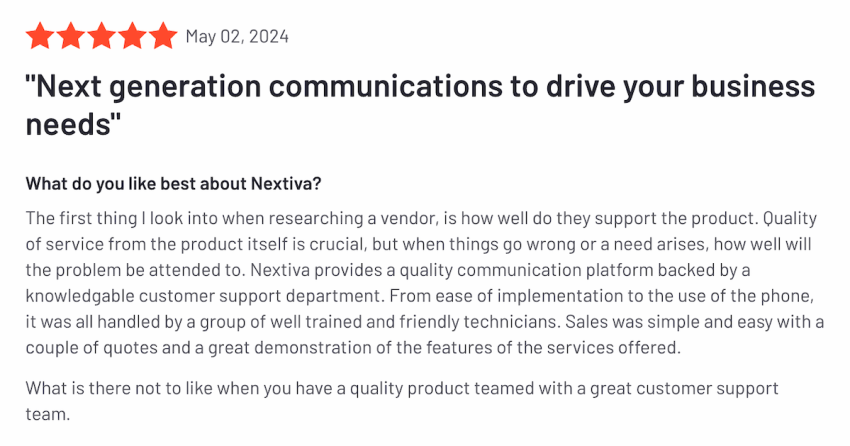
Why Customer Reviews Are Important
Before you get into the “how,” let’s first clarify the “why.” Customer reviews are more than just a star rating, and a critical differentiator for any business.
- They build trust and credibility: Reviews can provide unbiased social proof. When potential buyers see that real people have had positive experiences with your business, it validates your claims and reinforces their purchase decision.
- They increase conversions and sales: A steady stream of positive reviews can directly impact your profits. Product pages with customer reviews convert better than those without. Customer feedback gives customers the final push to make a purchase decision.
- They improve SEO and online visibility: Search engines like Google use reviews as an important ranking factor, especially for local businesses. More reviews can increase your visibility in search results and on Google Maps, thus generating more organic traffic your way.
- They provide valuable feedback: Reviews are a direct line to your customers’ opinions. They offer honest feedback on what you’re doing right and where you can improve, providing valuable insights for product development and service adjustments.
- They build customer loyalty: Responding to reviews — both positive and negative — opens a dialogue. It shows that you value your customers’ opinions and are committed to their satisfaction, which strengthens customer loyalty and turns one-time buyers into repeat customers.
Types of Customer Reviews
Customer reviews come in several formats, each offering unique value.
Text reviews
Text reviews are written feedback provided by customers about their experiences with a product, service, or company.
They’re the most common form of customer reviews, and they can vary in length and detail, offering specific insights into what the customer liked or disliked. Key features include:
- Detailed descriptions of customer experiences.
- Can include both positive and negative aspects.
- Offer specific feedback that can guide potential customers and inform business improvements.
Star ratings
Star ratings are a quick and effective way for customers to communicate their level of satisfaction with a product or service.
They typically range from one star (indicating dissatisfaction) to five stars (indicating high satisfaction). Key features include:
- Provide a summarized visual indication of satisfaction.
- Easy for potential customers to interpret at a glance.
- Often accompany text reviews for a more comprehensive overview.
Video reviews
Video reviews are shared by customers through video platforms such as YouTube, social media, or on product pages.
These reviews can be particularly persuasive as they allow potential customers to see the product in use and hear directly from the reviewer, adding a layer of authenticity and trustworthiness.
Video reviews often cover the unboxing experience, product demonstrations, and overall impressions, providing a comprehensive view of the customer’s experience. Key features include:
- Highly engaging and can showcase the product in action.
- Add a personal touch, making the review feel more genuine and trustworthy.
- Allow for detailed demonstrations and explanations.
Image reviews
Image reviews consist of photographs posted by customers of a product or service, often accompanied by a text review.
These images can show the product in a real-world setting, highlight aspects of the service, or point out specific features or issues.
Image reviews help validate the claims made in text reviews, providing visual proof that can enhance credibility and influence purchase decisions. Key features include:
- Offer visual evidence of a product’s quality or a service’s outcome.
- Enhance the authenticity of written reviews by providing visual context.
- Can highlight aspects of a product or service that are difficult to describe in words.
9 Ways To Get More Customer Reviews
How do you actually get your customers to leave helpful reviews? Below are a few key strategies and examples to follow.
1. Provide an excellent, review-worthy experience
A positive review is the result of an exceptional customer experience. However, a great experience alone doesn’t always guarantee a review. Integrate it into the customer experience process.
- Make the request actionable: Don’t just hope for a review. Place a QR code on receipts, store signs, or product packaging that links directly to your preferred review platform.
- Respond to existing reviews: Actively respond to both positive and negative feedback. This shows potential reviewers that you’re listening and that their opinion is important, and encourages them to share their own.
- Empower your team: If a customer has a problem, let your team resolve it immediately. Turning a negative experience into a positive one is one of the most effective ways to earn a glowing review.
For example, the fast-food chain Wendy’s is known for building trust by promptly responding to negative customer feedback on social media and assuring customers that their concerns will be addressed.
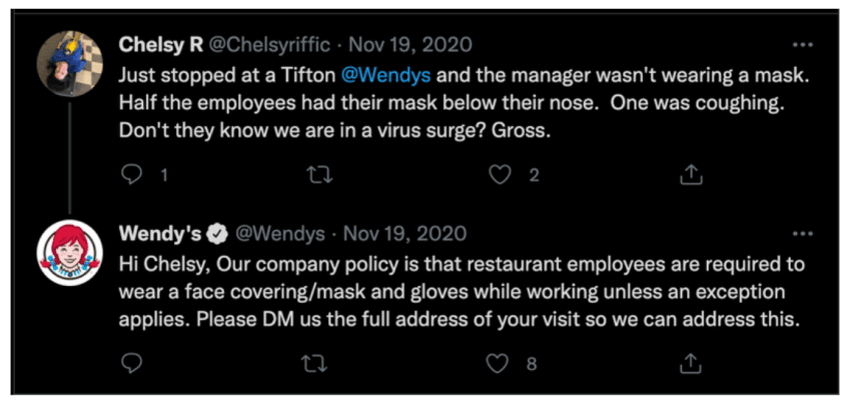
2. Choose the right moment to ask
Timing is crucial. Don’t wait until immediately after a purchase to ask your customers for a review. Instead, identify moments of peak customer satisfaction. This could be:
- After their first successful use of your product.
- When they make a repeat purchase or upgrade a service.
- Immediately after a positive customer experience.
- When your brand is tagged in a positive social media post.
Online pet supply retailer Chewy is a real leader here. They send personalized, automated emails asking for a review shortly after receiving an order to ensure the experience is still fresh in their minds.
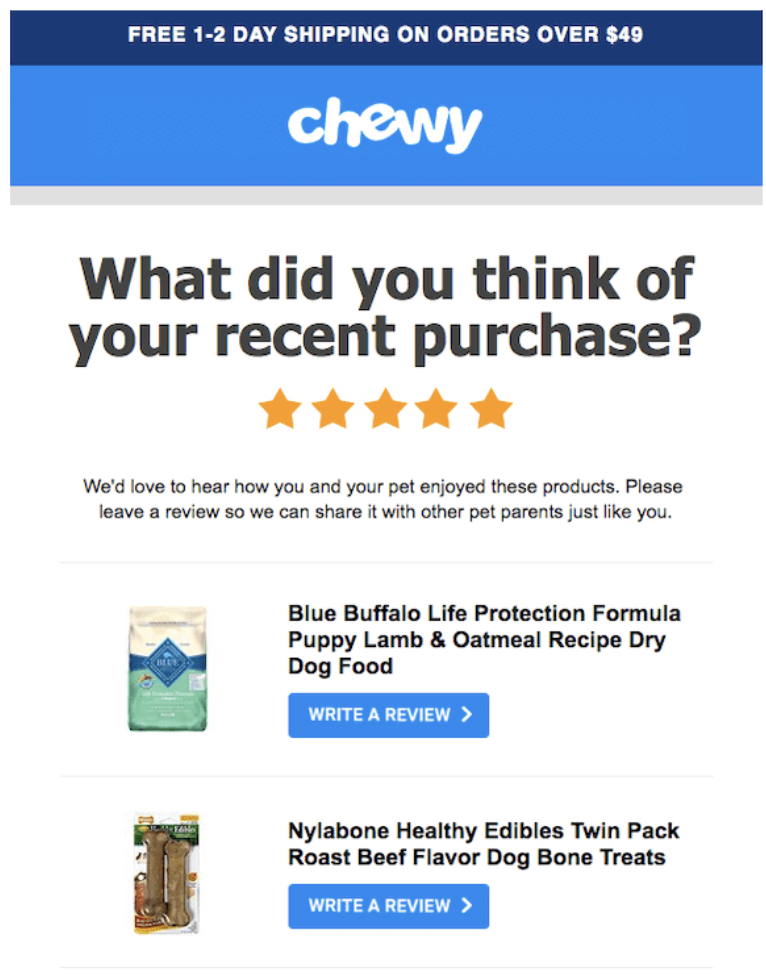
3. Simplify the review process
The easier it is to leave a review, the more likely customers are to do so. Remove any potential hurdles.
- Provide a direct link: If you’re asking for a review via email or text message, include a direct link that takes customers directly to the desired destination. Stationery company Papier is a good example. Its follow-up emails include a clear call to action and direct links that make leaving a review a seamless, one-click process.
- Avoid logins: Use review platforms that don’t require an account. The extra step of signing up can be daunting.
- Optimize for mobile: Make your review page mobile-friendly, as many customers leave feedback via their smartphones.
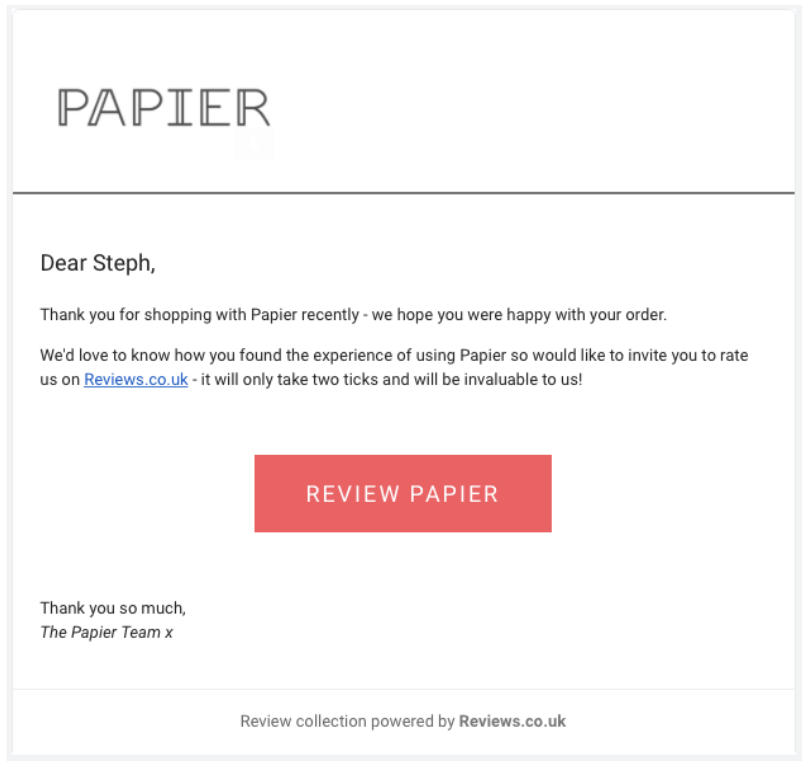
4. Use multiple review platforms
Your customers are active on multiple platforms, so your business should be too. A presence on multiple relevant websites increases your visibility and credibility.
- Increased visibility: The more frequently your business is listed, the more likely potential customers are to find you.
- Improved SEO: Positive reviews on multiple platforms send strong signals to Google and help you rank higher in search results.
- Build broad trust: Take Nextiva, for example. By maintaining a strong presence on trusted B2B review platforms like Trustpilot, the company builds credibility within its industry, complementing its reviews on broader platforms.
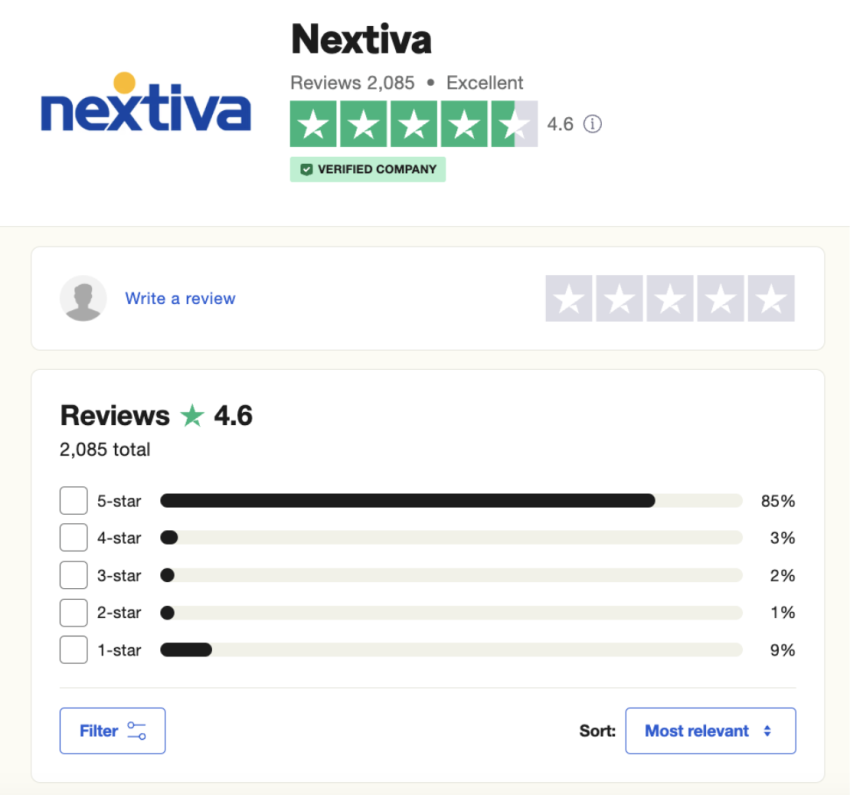
5. Scale your review requests
To generate a steady stream of reviews, you need to follow up regularly. Manually surveying each customer doesn’t scale, so automation is crucial.
- Automate your requests: Use your email marketing or review management software to set up automated campaigns that trigger a review request a set number of days after a purchase or delivery.
- Send a polite follow-up: If a customer doesn’t leave a review after the initial request, send a friendly reminder a week later.

6. Reward customers for their loyalty
While you should avoid directly “buying” positive reviews, you can incentivize feedback in transparent ways.
- Offer a small discount: Provide 10% off their next purchase as a thank you for their time.
- Run a contest: Enter everyone who leaves a review in a given month into a drawing for a larger prize, like a gift card.
- Create a loyalty club: Software marketplace G2 effectively uses this strategy by offering small gift cards for honest, verified feedback, helping them garner millions of trusted reviews while remaining transparent about the reward.

7. Personalize the review experience
A generic mass email is easily ignored. Personalization shows customers that you see them as individuals, not just order numbers.
- Use names: Always address customers by their first name.
- Refer to the purchase: Mention the specific product or service they used. For example: “Hi Jane, we’d love to hear how you like your new espresso machine.”
- Explain why it’s important: Personalized review requests can be automated. Tools on platforms like Nextiva can send highly personalized automated email responses that address different customer interactions. This makes the request feel less like a mass message and more like a personal conversation.

8. Use AI and ORM software
Online reputation management (ORM) software simplifies review management. Modern ORM platforms like Nextiva use AI to streamline the entire process.
- AI-powered requests: Use AI to automatically create and send personalized review requests at the optimal time for each customer.
- Intelligent replies: AI can create contextual replies to common reviews, allowing you to respond quickly and personally.
- Sentiment analysis: For example, a restaurant can use an ORM platform like Nextiva to consolidate reviews from Google, Yelp, and Facebook into a single dashboard and use AI to create quick, personalized replies to each review.
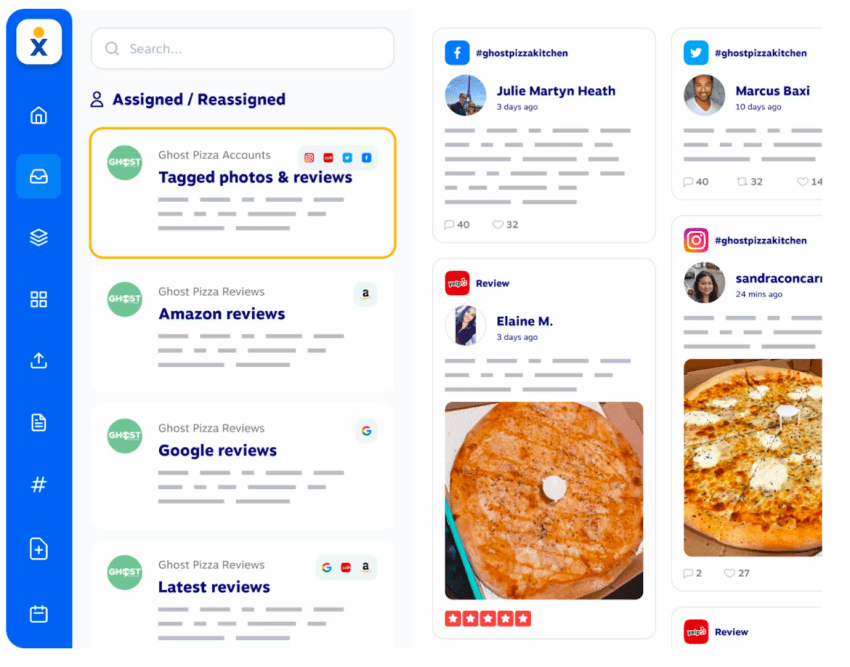
9. Suggest a specific aspect for customers to review
Sometimes customers want to leave a review but don’t know what to say. Guide them by asking them to comment on a specific aspect of their experience, such as “How was our delivery speed?” or “What’s your favorite feature of the new software?” This makes it easier for them to write and results in more specific, helpful reviews.
Where To Get Customer Reviews: Best Websites for Your Business
The best review sites vary by industry. Customers already search in specific places for recommendations, so you need to focus on the platforms that matter most to them. By doing so, you’ll collect product reviews that drive real traffic and sales.
- For almost any business, Google Business Profile is a must-have. Facebook is another good place for customers to leave a quick review.
- For local services: Yelp is one of the most important platforms for local businesses like restaurants, salons, or contractors.
- For B2B & SaaS companies: G2 and Capterra are the top review sites for software and business tools.
- For e-commerce businesses: Amazon reviews carry a lot of weight. Trustpilot is another good option because it works across industries.
- For travel & hospitality: TripAdvisor dominates reviews for hotels, restaurants, and attractions.
How To Use Customer Reviews Effectively
Getting reviews is only the start. The real value comes from how you respond, share, and learn from what customers say.
Address negative feedback immediately
Reply to bad reviews within a day. Speak directly, stay respectful, and invite the customer to talk privately if needed. A quick, thoughtful response shows you care and take concerns seriously. Maintaining this approach improves your response rates, which customers notice and appreciate.
When you handle criticism well, you can even turn it into an advantage. Many satisfied customers update or change their reviews once they see strong customer support and accountability.
Use positive reviews as marketing assets
Share positive reviews, especially 5-star reviews, instead of leaving them hidden on review sites. Post your best testimonials on product pages, your homepage, and social channels where new customers will notice them. Use them in ad campaigns to provide real proof from real people.
Highlighting genuine feedback builds trust, because reviews work better than claims from the business itself. When buyers see others vouch for you, they feel more confident about choosing your brand.
Analyze feedback for business improvements
Read reviews often and watch for patterns. Repeated praise points to strengths you should build on, while recurring complaints or negative reviews show where you must fix the root cause. Reviews give you direct insight into customer expectations. By acting on them, you can refine products, improve processes, and adapt your business to meet customer needs more effectively over time.

Reviews Should Be Authentic, Fun, and Mutually Beneficial
It’s not always easy to get customer reviews, but if you approach it strategically, you can start immediately. Ensure you give customers a good reason to put in a good word for you. It’s about how well you can turn negative customer feedback into opportunities for improvement.
Stay true to your values by serving your customers in the best possible way. Your reviews will speak volumes for you.
See what Nextiva can do for your CX.
Short on time? Experience our AI-powered contact center in minutes through quick, on-demand demos.

















 Marketing & Sales
Marketing & Sales 








